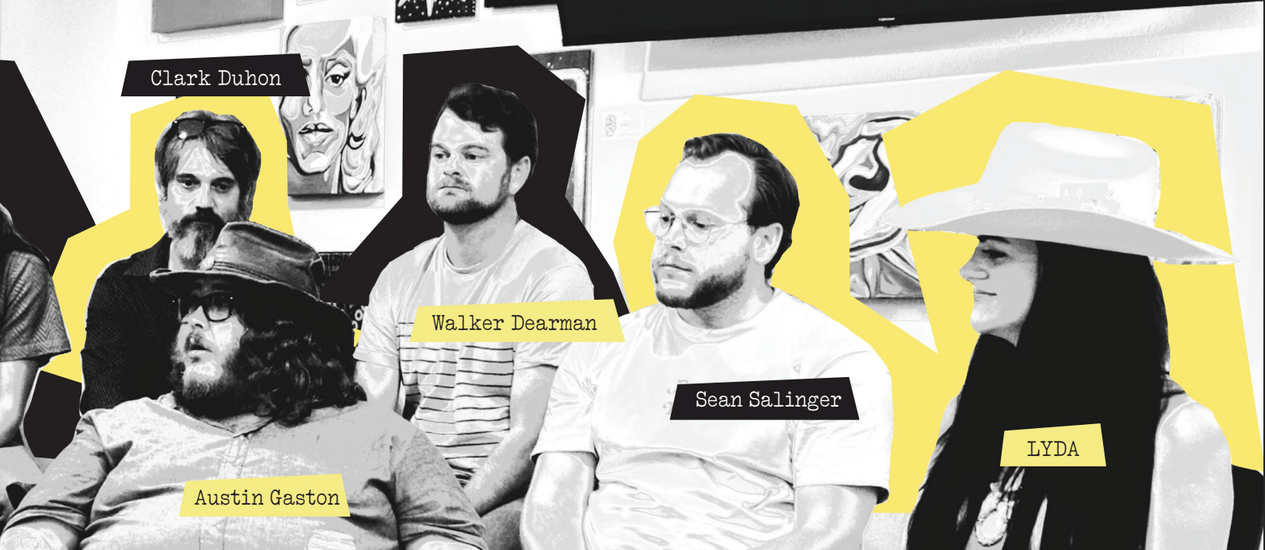Galveston Musician's Roundtable
- janesemaricelli
- Apr 30
- 4 min read
Austin Gaston, Benji Ramsel, Alana Stevenson, LYDA, DJ Xyla, Sasha Francis, Sean Salinger, Walker Dearman, Clark Duhon
For this issue of Culture Clash, we went straight to the source. We brought together a crew of Galveston’s own musicians, pulled up some chairs, and asked them to get real about the island’s music scene—what’s working, what’s missing, and what makes it magic. Steering the conversation is Culture Clash publisher Janese Maricelli, who gets the insiders’ take on the sound, soul, and struggles of making music on the sandbar. Here’s what they had to say.
Janese: What draws you to Galveston as a place to make music?
Benji: The talent here is off the charts—per capita, I’ve never seen a place like it.
Austin: It’s the spirit of the island—romanticism, architecture, food, music. It pulls people in and inspires creativity.
Sasha: It’s easier to get in a creative space here. You step outside and see the ocean, birds, beauty—it’s like we live in a permanent vacation.
Walker: Galveston has this deep history. People all over the world know the name, and there are so many songs about it.
Janese: What’s the scene like right now?
Austin: It’s wildly diverse. You get every genre and so many perspectives. There’s something for everyone.
Janese: LYDA, you grew up here—how has the scene changed?
LYDA: It’s grown a lot. When I was starting out, Mod Coffeehouse was the only real venue. Now there’s more opportunity, more venues, and recognition—being named Music City of Texas was a big deal. I feel like I’m helping shape the next phase.
Janese: That Music Friendly designation—how do you feel about it?
Benji: Right now, it feels like a tourism label more than actual support.
Austin: The city has to do more than just stamp a title on us—they need to support it for real.
Sasha: Exactly. Fund the music and stop penalizing street performers. Venues like Mod and Proletariat are showing up, but the city still has work to do.
Walker: It’s like the city got a cool jacket but hasn’t figured out how to wear it yet. We need venues to support original music—not just cover bands for tourists.
Benji: Yeah, we’re not here to play Jimmy Buffett all day.
Janese: Speaking of, how do you feel about the balance between cover bands and original music?
Austin: Covers are fun, but originals matter. We’ve got so many artists trying to share their own work.
LYDA: Most of us mix covers and originals. It’s not black and white—just a balance.
Sasha: When I moved here, it was mostly cover bands. That’s shifted. People are stepping into their original work, and audiences are open to it.
Austin: The more original music people hear, the more they expect and appreciate it. We’re creating that culture.
Sasha: It’s vulnerable to put your own songs out there. Some folks start with covers until they believe in their voice. But here, we have room to do both.
Janese: DJ Xyla, you bring a different style to the scene—how’s that been?
DJ Xyla: It’s a challenge. My sound—dark techno, opera, classical—isn’t common here. But I love how Galveston’s gothic vibe fits it. I did a Victorian techno rave at Ashton Villa with live musicians, opera, dancers—super collaborative and cool. Galveston Arts Center has been great, too. Some bars though—eh, they just want Top 40 and don’t care about the vision. That’s the struggle: finding venues that value creativity, not just background noise.
Janese: Let’s name some venues that really support local artists.
All: Hotel Lucine.
Austin: 1877, Old Galveston Club, Old Quarter.
Sasha: Big shout-out to Becky Major and the Misfits Group—they really trust artists to do their thing. Also, Marmo has been super welcoming.
Benji: DTO.
LYDA: Maceo’s.
Lana: Indies—they’re even live-streaming shows now.
Janese: Alright, final round—what’s been your most memorable performance in Galveston?
LYDA: My first show at Mod when I was 17. I was so nervous I cried after, but people loved it. That moment kept me going.
Austin: The Sandcastle Festival. Huge crowd, wild energy—I felt carried by something bigger than myself.
Benji: The Shrimp Festival is always a blast. But I think my favorite show is still coming—probably La Izquierda Fest.
Sean: A Proletariat show before they were even open. We pulled extension cords through the lofts and used construction lights—classic Galveston hustle.
Sasha: That’s so Galveston. We also played a masquerade ball at Marmo with a full band, aerial silks, burlesque—so many art forms colliding. Magical.
Walker: Mardi Gras, 2012. The crowd was far back at first, but by the third song, they all rushed the stage. That rush of connection is unforgettable.
DJ Xyla: That Victorian techno rave—just the fact that it happened here says so much about Galveston’s openness to weird, wonderful creativity.
Clark: Mardi Gras balcony sets, in between marching bands, with crowds below—pure energy. Also, the house party scene here is real—people listen to the music.
Janese: Galveston really is the Wild West of coastal towns—anything goes. Thank you all for your music, your energy, and your creativity. You’re the reason I started this magazine—for us, by us. You’re making it happen, and I’m so grateful.



























Comments